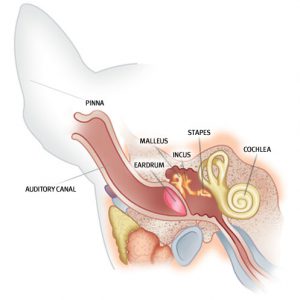Causes of Ear Disease
Some breeds are more susceptible than others, including dogs with pendulous ears or dogs with hairy inner ear flaps. Dogs with allergies are also at risk.
Otitis Externa infection of the external ear canal and Otitis Media, infection of the middle ear are usually caused by bacteria and/or yeast. Other possibilities include accumulation of wax, matted hair, debris or a foreign object lodged in the ear canal. When seeking treatment, act quickly. If your dog has an ear infection, he/she will be in considerable discomfort. Antibiotics are used for bacterial infections while antifungals are administered for yeast. Ear infections can also be indicative of other problems such as underlying allergies. Your veterinarian will determine this during your visit and suggest the best course of action.
Ear Mites are common parasites that are highly contagious, often contracted from pet to pet. Excessive itching is the most common sign. Ear mites create dark, crumbly debris that look like coffee grinds.
Aural Haematoma means blood has accumulated in the ear flap (pinna). The exact cause of this condition in many cases is still unknown, but can sometimes be caused by vigorous head shaking, scratching or trauma to the ear area resulting in damage to the blood vessels, often set off by infection, mites, fleas or debris.
Deafness, usually brought on by age, trauma, loud noise or infection, can also be hereditary or congenital. Unfortunately, once diagnosed with clinical deafness, it is a lifelong condition.






